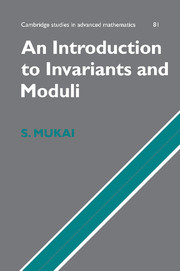Book contents
- Frontmatter
- Contents
- Preface
- Acknowledgements
- Introduction
- 1 Invariants and moduli
- 2 Rings and polynomials
- 3 Algebraic varieties
- 4 Algebraic groups and rings of invariants
- 5 The construction of quotient varieties
- 6 The projective quotient
- 7 The numerical criterion and some applications
- 8 Grassmannians and vector bundles
- 9 Curves and their Jacobians
- 10 Stable vector bundles on curves
- 11 Moduli functors
- 12 Intersection numbers and the Verlinde formula
- Bibliography
- Index
- References
6 - The projective quotient
Published online by Cambridge University Press: 05 February 2015
- Frontmatter
- Contents
- Preface
- Acknowledgements
- Introduction
- 1 Invariants and moduli
- 2 Rings and polynomials
- 3 Algebraic varieties
- 4 Algebraic groups and rings of invariants
- 5 The construction of quotient varieties
- 6 The projective quotient
- 7 The numerical criterion and some applications
- 8 Grassmannians and vector bundles
- 9 Curves and their Jacobians
- 10 Stable vector bundles on curves
- 11 Moduli functors
- 12 Intersection numbers and the Verlinde formula
- Bibliography
- Index
- References
Summary
Let G be an algebraic group acting on an affine variety X. In the last chapter we discussed the following strategy for defining a quotient variety of X by G:
(A) For suitable G-invariant functions f1, …, fn ∈ k[X]G, consider the map to affine space
X → An, x ↦ (f1(x), …, fn(x)),
and take for the quotient the image of this map.
In this manner we constructed quite explicitly a moduli space for nonsingular hypersurfaces in ℙn; and by gluing together affine varieties obtained in this way (in other words, using Proj) we constructed a compactification of the moduli space.
Although at an elementary level this approach works well, the following improvement has a wider scope for applications:
(B) f0, f1, …, fn need not be G-invariants, nor even regular functions on X, but their ratios fi/fj should all be G-invariant rational functions. (To be precise, the fi should be G-invariant sections of a G-linearised invertible sheaf – see Section 6.2.) Thus chosen, we have a rational map (that is, a map defined on a nonempty open set in X) to projective space
X − − → ℙn, x ↦ (f0(x) : f1(x) : … : fn(x)),
and we take the image of this map.
Just as we arrive at an affine variety Spm k[X]G via (A), via (B) we arrive at a projective quotient, often called the GIT (geometric invariant theory) quotient. While (A) is the basic technique for constructing a quotient locally, (B) is generally more useful for constructing quotients globally. In fact, (A) is just the special case of (B) in which one takes f0 = 1 and G-invariant regular functions f1, …, fn. Moreover, the point of view of (B) is closely related to the so-called ‘moment map’, which allows one to construct symplectic reductions of symplectic manifolds and complex Käahler manifolds.
Note that the map to projective space in (B) fails to be defined at the common zeros of f0(x), f1(x), …, fn(x).
- Type
- Chapter
- Information
- An Introduction to Invariants and Moduli , pp. 181 - 210Publisher: Cambridge University PressPrint publication year: 2003

